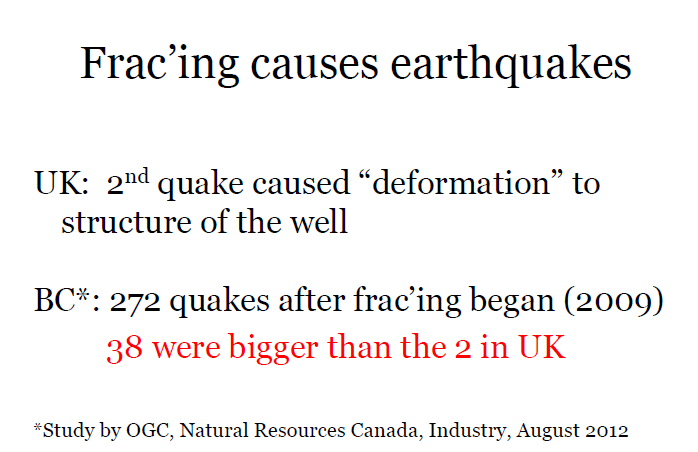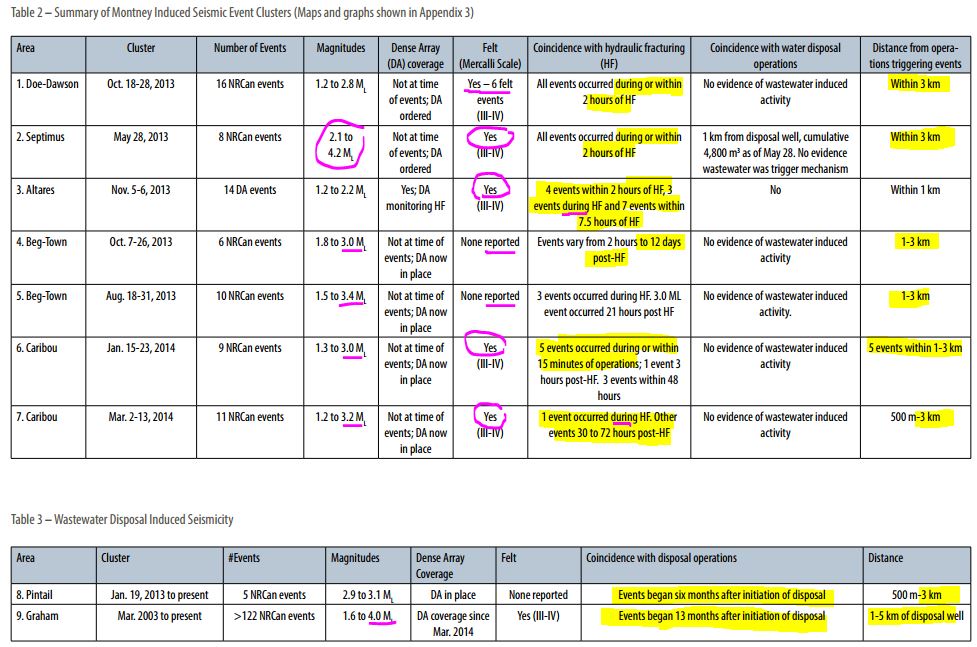Alberta fracking quake, An earthquake last week may have been the strongest ever caused by fracking by CBC News The National, January 30, 2015
Fracking possible cause of 4.4-magnitude Fox Creek earthquake by David Howell, January 30, 2015, Edmonton Journal
The Alberta Energy Regulator is investigating an earthquake near Fox Creek this month that may be linked to hydraulic fracturing. On Jan. 22, the AER confirmed a “seismic event” with a magnitude of 4.4 on the Richter scale about 33 kilometres west of Fox Creek, which is 260 km northwest of Edmonton. There were no surface impacts and no damage was reported, AER spokesman Peter Murchland said via email Friday. [Would the oil and gas industry report damages caused by frac or drilling induced earthquakes? Is anyone looking at the damages underground, surface water and to aquifers?]
“Preliminary information indicates the event may be related to hydraulic fracturing operations in the area,” Murchland said.
“It is, however, impossible to state that it was not a naturally occurring event.” [Integrity, “No Duty of Care” tongue twister?]
In 2014, an expert panel’s report on the environmental impacts of shale gas extraction in Canada found that while hydraulic fracturing has caused small earthquakes, seismic risks related to it are low in most regions. [The panel that publicly lies, promotes propaganda and left out of their review the most damning regulator and industry research and data? ]
A larger concern is the re-injection of waste water into the target formation after the hydraulic fracturing process has been completed, the panel found. Seismic risk caused by the injection of waste fluids can be larger than for hydraulic fracturing, but minimized by careful site selection and monitoring [This is standard industry escape hatch wording. IS “CAREFUL SITE SELECTION AND MONITORING” BY THE OIL AND GAS INDUSTRY TAKING PLACE IN CANADA? Industry selects their waste dumping sites to be as fast, easy and as cheap as possible. ] to ensure that excessive injection does not occur,” the panel said in its report, prepared for the federal government.
The Jan. 22 event was “one in a sequence of lower-level seismic events in the Crooked Lake area beginning in early January,” Murchland said. According to Natural Resources Canada, there were two significant earthquakes near Fox Creek in January. The [4.4 magnitude, the largest reportedly caused by hydraulic fracturing so far] Jan. 22 quake, which occurred at 11:49 p.m., was “lightly felt” in Fox Creek, the department said. At 9:06 a.m. on Jan. 14, a 3.8-magnitude earthquake was measured 38 km west of Fox Creek. There were no reports of damage “and none would be expected,” Natural Resources Canada said. It is considered highly unlikely that an earthquake with a magnitude less than 5.0 could cause any damage. [Who is checking underground?]
Murchland said the Alberta Geological Survey, which is part of the AER, is studying the Jan. 22 event to understand likely causes.
It occurred in a part of the Duvernay shale play where the AER is conducting a pilot project into play-based regulation. The pilot is seen as a first step in moving toward a proposed new [de]regulatory [one size fits all harms, 100% industry controlled, “No Duty of Care” blanket approval] framework for unconventional oil and gas development.
In the wake of the Jan. 22 earthquake, energy companies have not been told to change any of their activities. But Murchland said they are being reminded of their responsibility to ensure well control and subsurface integrity at all stages of drilling, completions and injection operations.
The Alberta Geological Survey uses 53 monitors to track seismic activity in the province. Since it began monitoring in 2010, it has added eight more seismic stations. Six are located in the Fox Creek area. Murchland said locations were chosen after modelling showed areas where lower-magnitude events could be detected.
From 1985 to 2010, Earthquakes Canada recorded 471 earthquakes in Alberta.
The majority were naturally occurring earthquakes in the foothills of the Rockies, but “clusters of activity have been observed in regions associated with gas production,” the Alberta Geological Survey says. Most Alberta earthquakes are minor. [How will the AER and industry change their story next year?] They usually have a magnitude of less than 3.0 and aren’t felt except by people who are directly above the epicentre. [Emphasis added]
Debunked or AER Backtracking? Fox Creek earthquake not confirmed as linked to fracturing by Markham Bishop, January 30, 2015, Beacon News.ca
If you believe Andrew Nikiforuk of The Tyee, Alberta broke a world record on Jan. 22 for the strongest earthquake induced by hydraulic fracturing operations. But the Alberta Geological Survey says scientists haven’t collected the data yet to concluding fracturing was even the cause of the 4.4 Fox Creek earthquake.
Natural Resources Canada recorded the quake just before midnight 30 kilometres west of Fox Creek (268 kilometres WNW of Edmonton). According to the Alberta Energy Regulator, in December 2013 there were 18 seismic events between magnitudes 2.7 and 3.7 recorded in the region and in mid-January 2014 five events were recorded between magnitudes of 2.4 and 3.8. Earthquake swarms are one of the signs of fracturing-induced seismic activity.
…
Hydraulic fracturing – pumping fluid downhole at high pressures to fracture geological formations and free up oil and gas – does cause small earthquakes, though they are rarely felt at surface. [Why not report that the regulator in BC recently proved this wrong?] In 2012, the BC Oil and Gas Commission released a report on 272 minor seismic events (2 to 3.8 magnitude) that scientists concluded were induced by fracturing. [With damages so severe to casing, one well couldn’t be completed. How many dollars and resources were lost because of frac induced quakes in NEBC?] Only one was felt at surface, faintly by a brush crew.
[Reality check: Did Mr. Bishop and Beacon News talk to the regulator in BC about their new, very damning frac quake report just released at the end of 2014 with the many “felt” quakes proven caused by fracing? Why only report on the old report and not the new one? An urge to propagandize and diminish the truth about “felt” earthquakes?
Above data from the BC regulator’s new frac induced quake report on 11 “felt” quakes
The Tyee also reported on this new BC regulator report
Sometimes, my media colleagues mistakenly attribute earthquakes to fracturing when the cause is something else, such as the 13 small quakes that CBC reported last November were the fault of fracturing when the real culprit was a waste-water disposal well. [Where did the waste come from that had to be injected? The Superbowl?]
Fox Creek earthquake
The Fox Creek quake may have been induced by fracturing, but Dr. Todd Shipman, manager, landscapes and geological hazards, of the Alberta Geological Survey [100% CONTROLLED BY THE OIL AND GAS INDUSTRY] says his team has not yet gathered the data from the service company crews so they can correlate seismic data with pumping information. “There’s information we don’t have from operators. We’re trying to collect that information,” Dr. Shipman said in an interview with Beacon News. “We don’t have pump rates or activity.” [WHY NOT? WHAT KIND OF A REGULATOR DOES NOT HAVE THAT INFORMATION BEFORE AND DURING “IGNORANT, BRUTE FORCE” EXPERIMENTS? JUST HOW IRRESPONSIBLE IS THE “NO DUTY OF CARE” AER AND IT’S DATA-LESS GEOLOGICAL SURVEY? WHAT KIND OF A “SURVEY” DOESN’T HAVE ALL THE DATA ON HAND TO MONITOR THIS BLANKET APPROVAL PILOT PROJECT?]
Shipman says earthquakes can occur at various times within the fracturing cycle, such as when the crew is pumping, after it stops, or when they withdraw fluid. Once scientists get the data from the service company, they can crunch the numbers and look for correlations between quake activity and fracturing activity. [When your home is falling on you, putting your loved ones’ lives at risk, do you care if the quaking and shaking is caused before, during or after the drilling and fracing or associated waste injection?]
Shipman cautions that scientists can never state with certainty that fracturing induces earthquakes. [Of course not! Doubt and asking questions (Alberta regulators punish when harmed citizens do the asking) is what makes science. Law, however, only requires a 51% balance of probabilities to prove damages in court – if one is in a province where there is access to justice for harmed citizens.]
“We look for correlation, we look for likelihood, but you’re never going to have a definitive answer,” he said.
The strength of the 4.4 quake is so unusual it raises the question if the tremor was caused naturally, says Dr. Shipman.
It also begs the question if seismologists should be worried about magnitude or effect on surface. Dr. Shipman explains that in some regions, like Oklahoma, earthquakes of 2.0 or less have been felt on surface. And regulators become concerned when people feel quakes or have their property damaged.
“Whether it’s natural or induced, this is something we have to address,” he said. “We’re [Alberta Geological Survey] in the process of coming out with a [100% industry controlled] response to this.”
In the meantime, claims of fracturing-induced earthquakes should be based on analysis by seismologists who have completed their analysis and speak confidently about correlation and causation. [Which they did, before the 100% industry controlled AER/AGS backtracking began]
Otherwise, such claims are propaganda, not news. [Like the backtracking reporting in this article?]
[Refer also to:
…
“The question is: Is it all about profits, or do the people have any rights at all?” said Robert Freeman, 69, a retired Air Force contracting officer….
…
Meanwhile, the state seismologist, Austin Holland, readily acknowledged that the industry has tried to influence his work — even as he and his colleague, Amberlee Darold, are pelted with “hate e-mail” from quake victims.
“I can’t really talk about it,” Holland said, taking a cigarette break from the dirty work of burying instruments near a cow pasture southwest of Oklahoma City. “I try not to let it affect the research and the science. We’re going to do the right thing.”
For the most part, Oklahoma oil companies and their representatives have declined to engage in the public debate. When industry representatives have ventured forth, they have denied responsibility for the quakes. At a luncheon hosted by the Oklahoma City Geological Society last summer, Glen Brown, a Continental Resources geologist, blamed a worldwide surge in seismic activity that has nothing to do with wastewater disposal. [Emphasis added]


